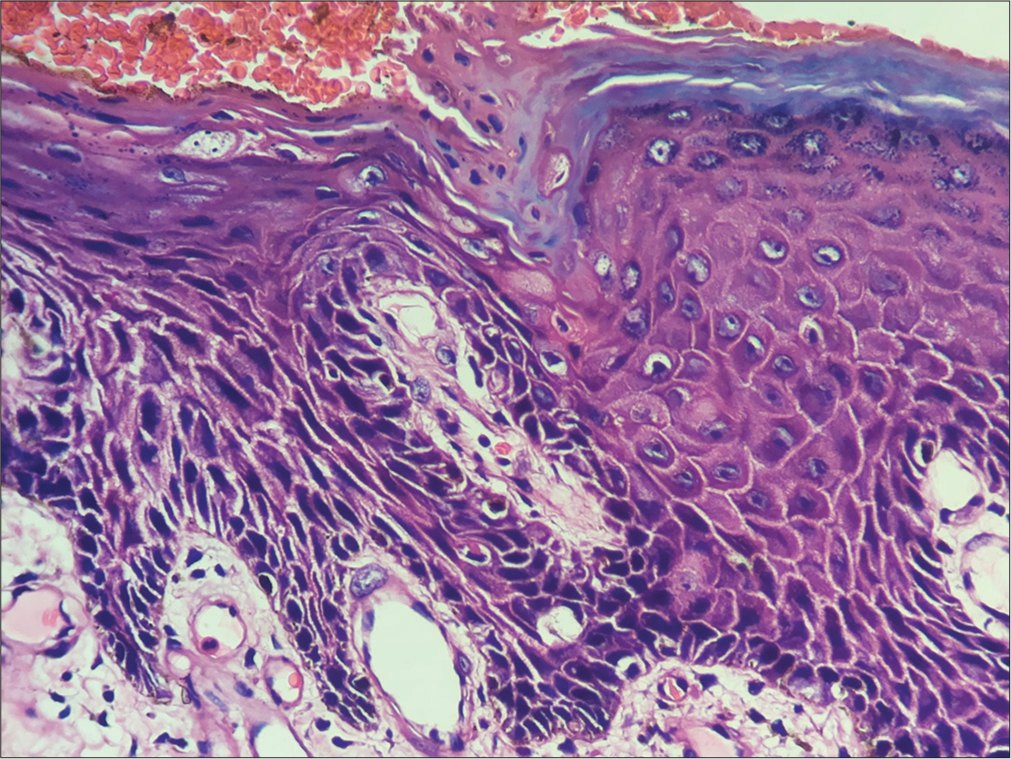Translate this page into:
Penoscrotal porokeratosis: An uncommon entity

*Corresponding author: Anupam Das, Department of Dermatology, KPC Medical College and Hospital, Kolkata,West Bengal, India. anupamdasdr@gmail.com
-
Received: ,
Accepted: ,
How to cite this article: Raza S, Das A, Shah H. Penoscrotal porokeratosis: An uncommon entity. CosmoDerma. 2024;4:26. doi: 10.25259/ CSDM_12_2024
A 29-year-old gentleman presented with a four-month history of redness, mild pruritus, and discomfort over the scrotum and shaft of the penis. There was a history of application of topical steroids and antifungal combination creams, but there was no change in the lesions. Mucocutaneous examination revealed multiple well-circumscribed annular plaques characterized by a typical thready raised margin distributed over the scrotum and base of the penis extending toward the shaft [Figure 1]. There were no similar lesions elsewhere in the body. Hair, nails, and mucosae were normal. Venereal disease research laboratory test was non-reactive, and routine laboratory investigations were within normal limits. Punch biopsy followed by histopathology revealed classical cornoid lamella [Figure 2]. Based on clinicopathological correlation, a diagnosis of penoscrotal porokeratosis has been made. He has been prescribed mometasone furoate 0.1% cream.

- Multiple well-circumscribed annular plaques with a thready border.

- Photomicrograph showing parakeratotic column of cells overlying hypogranulosis (H&E, ×100).
Penoscrotal porokeratosis is classically seen in young men in their third decade of life. Patients usually present with extremely itchy plaques and patches with a rough granular surface distributed over the shaft of the penis and anterior scrotum.[1,2] Differential diagnoses of penoscrotal porokeratosis include lichen planus, psoriasis, sarcoidosis, and secondary syphilis.
Ethical approval
The Institutional Review Board approval is not required.
Declaration of patient consent
The authors certify that they have obtained all appropriate patient consent.
Conflicts of interest
There are no conflicts of interest.
Use of artificial intelligence (AI)-assisted technology for manuscript preparation
The authors confirm that there was no use of artificial intelligence (AI)-assisted technology for assisting in the writing or editing of the manuscript and no images were manipulated using AI.
Financial support and sponsorship
Nil.
References
- Penoscrotal porokeratosis: A distinct entity. Indian Dermatol Online J. 2015;6:339-41.
- [CrossRef] [PubMed] [Google Scholar]
- Porokeratosis: An enigma beginning to unravel. Indian J Dermatol Venereol Leprol. 2022;88:291-9.
- [CrossRef] [PubMed] [Google Scholar]





